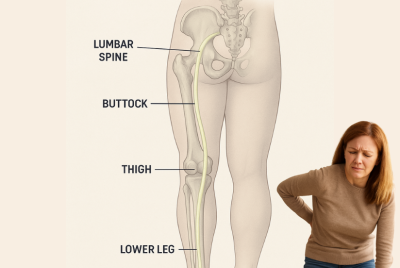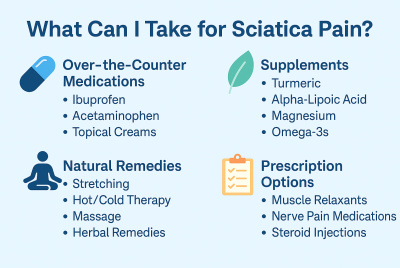Sciatica Prevention Tips
Discover effective sciatica prevention tips to avoid pain, improve posture, stay active, and protect your spine with simple lifestyle changes! Have you ever felt a sharp, radiating pain shooting down your leg that seems to come out of nowhere? If you have, you might already be familiar with sciatica. It’s one of those problems that, once you’ve experienced it, you never want to deal with again. The good news? You can take steps to prevent sciatica and avoid that uncomfortable, nagging pain. As someone who has helped many people manage and prevent sciatica, I’m here to walk you through simple, practical tips to protect your sciatic nerve and keep your back and legs in good shape. Let’s get started!
Understanding Sciatica
What is Sciatica?
Sciatica is a condition caused by irritation or compression of the sciatic nerve, the largest nerve in your body. This nerve runs from your lower back, through your hips and buttocks, and down each leg. When this nerve gets pinched or inflamed, it can result in pain, tingling, numbness, or weakness that typically affects only one side of your body.
Causes of Sciatica
The most common cause of sciatica is a herniated disc in your spine, which presses on the nerve. Bone spurs, spinal stenosis (narrowing of the spine), and even simple lifestyle habits like prolonged sitting or poor posture can also lead to sciatica. It’s like a perfect storm of bad habits and structural issues teaming up against you.
Common Symptoms
The hallmark symptom of sciatica is pain that starts in your lower back and radiates down one leg. You might also experience numbness, tingling, or even muscle weakness in the affected leg. It can feel like an electric jolt, and sometimes, even sneezing or coughing can worsen the pain.
Lifestyle Adjustments to Prevent Sciatica
Prioritize Good Posture
Sitting Posture: If you spend hours at a desk or behind the wheel, poor posture can wreak havoc on your spine. Always sit with your back straight, shoulders relaxed, and feet flat on the floor. Consider using a small cushion or lumbar roll to support your lower back.
Standing Posture: When standing, think of yourself as a tree—firmly rooted with a straight trunk. Keep your shoulders back, and avoid shifting your weight onto one leg for prolonged periods.
Exercise Regularly
Movement is medicine when it comes to sciatica prevention.
Core Strengthening: Your core muscles act like the foundation of a house, keeping your spine stable and strong. Exercises like planks, bridges, and bird dogs can help fortify this foundation.
Stretching for Flexibility: Stretches like the pigeon pose, hamstring stretch, child’s pose, or this simple stretch can help loosen tight muscles and improve flexibility, reducing pressure on the sciatic nerve.
Maintain a Healthy Weight
Carrying extra weight, especially around your midsection, can increase stress on your lower back and spine. This stress can lead to nerve compression and sciatica. A balanced diet rich in fruits, vegetables, lean proteins, and whole grains can help you maintain a healthy weight while providing nutrients that support nerve health.
Ergonomic Tips for Everyday Activities
Workstation Setup
Your workspace can either be your ally or your nemesis when it comes to sciatica prevention. Ensure your chair supports your lower back, your desk is at a height that allows your arms to rest comfortably, and your computer screen is at eye level to prevent neck strain.
Safe Lifting Techniques
Lifting heavy objects incorrectly is one of the fastest ways to irritate your sciatic nerve. Remember this simple rule: Bend at your knees, not at your waist. Keep the object close to your body and avoid twisting while lifting. Think of your legs as powerful springs doing the work, not your back.
How to Prevent Sciatica Pain When Sitting
Sciatica Prevention Tips – Stress
The Connection Between Stress and Pain
Stress affects more than just your mind; it can also wreak havoc on your body. High-stress levels can lead to muscle tension, which in turn can compress nerves, including the sciatic nerve. It’s like your body clenches up to deal with pressure, making you more vulnerable to pain.
Stress Management Techniques
Try yoga, meditation, or deep breathing exercises to manage stress. These practices can help you relax, improve your posture, and even boost your mood. Even a short walk in nature can do wonders for your mental and physical health.
Sleep and Sciatica Prevention
The Best Sleeping Positions
The way you sleep can either soothe or strain your back and sciatic nerve. If you’re a back sleeper, place a pillow under your knees to reduce pressure on your lower back. If you prefer sleeping on your side, tuck a pillow between your knees for better alignment.
Choosing the Right Mattress and Pillow
Invest in a medium-firm mattress that supports your spine’s natural curves. A mattress that’s too soft can make your spine sag, while one that’s too firm can push it out of alignment. Pair it with a pillow that keeps your neck aligned with your spine, whether you’re a side or back sleeper.
The Role of Regular Health Checkups
Your spine is like your body’s engine, and like a car, it needs regular maintenance. Routine checkups with a chiropractor or physical therapist can help catch potential issues early. These professionals can also recommend personalized exercises and treatments to keep your back healthy.
When to Seek Professional Help
Sometimes, sciatica symptoms don’t go away with self-care. If you experience severe pain, numbness, or weakness that interferes with your daily life, it’s time to see a doctor. Sudden loss of bladder or bowel control is a medical emergency and requires immediate attention.
FAQs Related to Sciatica Prevention Tips
Can sciatica be completely prevented?
While you can’t eliminate the risk entirely, especially if you have a genetic predisposition, healthy habits can significantly reduce your chances of developing sciatica.
How does stress worsen sciatica?
Stress can cause muscle tension, especially in the lower back and hips. This tension can compress the sciatic nerve, making symptoms worse or triggering new pain.
Is a firm mattress better for sciatica?
A medium-firm mattress is usually best. It provides enough support to keep your spine aligned while still offering some cushioning for comfort.
How can I tell if my sciatica is serious?
If your sciatica pain lasts more than a few weeks, is severe, or is accompanied by numbness, weakness, or loss of bladder control, it’s essential to seek medical help.
Are there any foods that help prevent sciatica?
Yes! Anti-inflammatory foods like salmon, leafy greens, nuts, and berries can help reduce inflammation in your body and support overall nerve health.
What exercises are best for sciatica prevention?
Core-strengthening exercises like planks and bridges are excellent. Stretching routines, including hamstring stretches and the pigeon pose, can also help prevent tightness that leads to sciatica.
Sciatica Prevention Tips – Conclusion
Preventing sciatica is all about making mindful choices to support your spine and overall well-being. You can significantly reduce your risk by maintaining good posture, staying active with regular exercise, managing your weight, and setting up an ergonomic workspace. Don’t underestimate the power of stress management and proper sleep habits to keep your sciatic nerve happy. Regular health checkups can catch potential issues early, keeping you ahead of the game. Remember, small changes in your daily routine can lead to big results. Prioritize self-care and consistency, and you’ll be well on your way to a life free from sciatica pain!
Disclaimer
Please note that this article should not replace professional medical advice. Consult a healthcare professional for an accurate diagnosis and tailored treatment plan.






